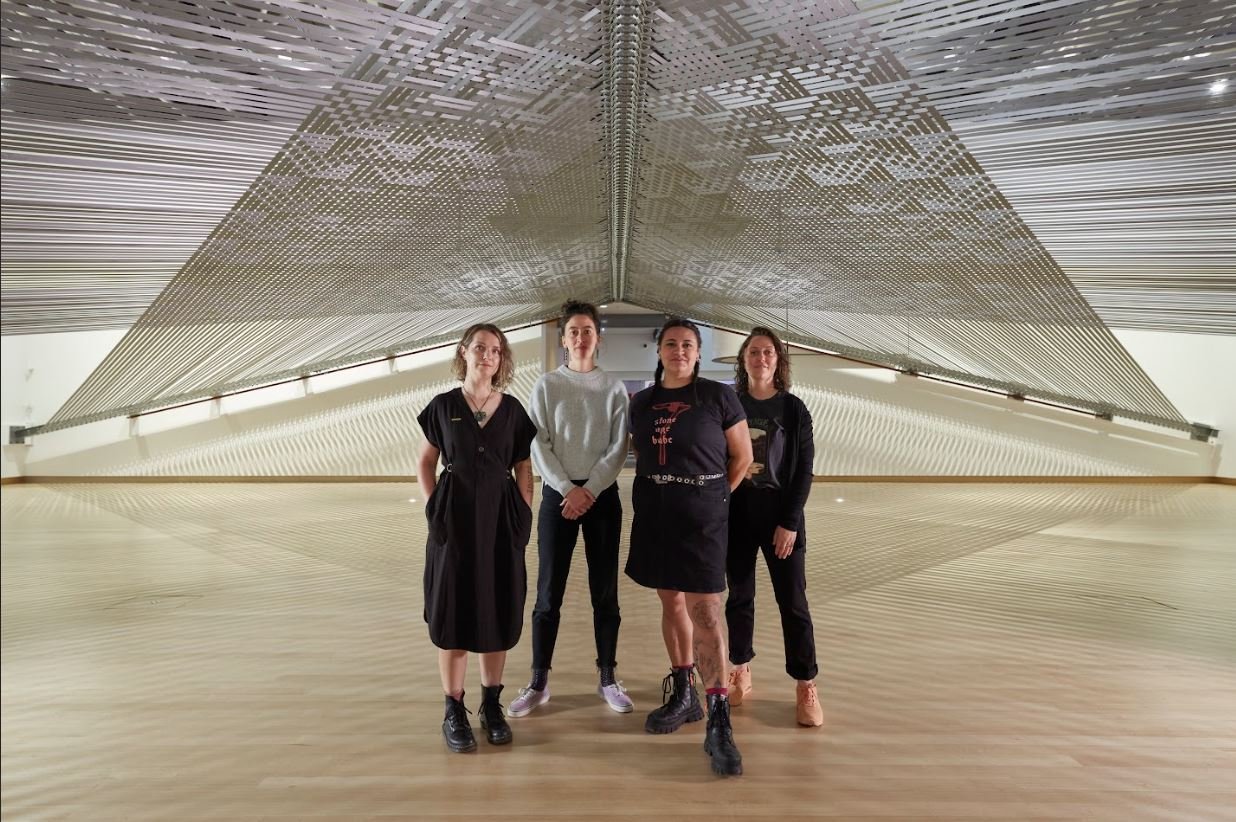
Mataaaho Collective: Te Puni Aroaro
By Hana Pera Aoake for Artlink in 2023
Hana Pera Aoake (Ngaati Mahuta, Ngaati Hinerangi, Waikato/Tainui, Waitaha, Ngaati Waewae ki Kai Tahu Poutini) is an artist, writer and independent researcher based in Aotearoa.
for my daughter: Te Whaea
an ancestor
returned to me in birth
this newborn
i love each of unfolding of her body
even her cry is celebrated
the Whaea that comes to reclaim
her place
in this place
assert her wholeness
—Roma Potiki
In the poem for my daughter: Te Whaea, Māori writer and artist Roma Potiki describes not just the archival memory instilled within each of us by our ancestors, but the ways in which whakapapa provides the principles that order the universe.[1] Often whakapapa is described as simply ‘genealogy’, but a better way of considering it would be layer upon layer. In Te Puni Aroaro, an exhibition by the Mataaho Collective at Te Papa o Tongarewa, calls to mind this complex web of whakapapa that orders the world for Māori people.
Formed in 2012, the collective create textile works at a scale that is difficult to comprehend. Mataaho are a group of four consists of Erena Baker (Te Atiawa ki Whakarongotai, Ngāti Toa Rangātira), Sarah Hudson (Ngāti Awa, Ngāi Tūhoe), Bridget Reweti (Ngāti Ranginui, Ngāi Te Rangi) and Terri Te Tau (Rangitāne ki Wairarapa). They describe their process of working together, producing work under a single collective authorship, as a practice that transcends their individual skills and talents. These larger-than-life installations are often made using textiles reflective of the realities facing modern Māori communities. Utilising industrial and surprising materials, they work with traditional Māori art techniques like raranga (weaving), as a way of signalling the liveliness and adaptability of Te Ao Māori.
I took my fifteen-month old daughter to see Te Puni Aroaro. The first work we encountered—by accident—was the newly commissioned Takapau (2023). From a floor above we looked down. There are multiple viewing perspectives for Takapau, suggesting there is no single way to understand it. From this aerial view we saw tight silver polyester hi-vis tie-downs secured from a ceiling made of 480 ratchets and stainless-steel buckles, fastened with 960 hooks. When looking up at Takapau, the light dances through the small gaps and the shadows of taniko weaving patterns fall gently on the skin.
It was here I reflected on the experience I had while giving birth to Miriama Jean. The word takapau refers to a finely woven mat often used for ceremonies, including childbirth. In Te Ao Māori, the womb provides a safe space for babies to grow connected to the gods. Takapau represents the moment of birth, a moment between light and dark or Te Ao Marama (the realm of light) and Te Ao Atua (the realm of the gods). Looking at Takapau I thought of my pregnancy and the ways in which my daughter’s cells migrate back and forwards in my bloodstream, many of them remaining in my body as a permanent imprint upon my tissues, bones, brain and skin. I also thought about people I loved and people I lost, and how this curious, chatterbox child reminded me of so many of them.
Another work in Te Puni Aroaro includes the exquisite Kiko Moana (2017) made through wānanga (a conference or forum) using the humble everyday material of a blue tarpaulin. Commissioned for Documenta 14, Kiko Moana is a cascading blue waterfall, draping eleven metres long. A physical embodiment of water, its sheer scale and vitality suggests it could be a space for a taniwha (water spirit) to live.[2] Similarly, Kaokao #1 and Kaokao #2 (both 2014) repurpose materials we would normally associate with construction and/or road workers (road sign vinyl and high-vis tape) and transforms them into a kaokao (chevron) pattern dedicated to the warrior who came under the protection of the war God, Tūmatauenga. Both works recall the strength and continuing endurance of women who protect the land, but also birth the future. These works are imbued with whakataukī (proverb), He wahine, he whenua, ka ngaro te tangata, which translates as ‘Without women and without land, humanity is lost’.
Te Whare Pora (2012) was the first work made by Mataaho. It consists of twenty faux-mink blankets—a staple in any Māori household—that has been transformed using customary Māori raranga (weaving) practices. Its title references the house of learning presided over by the female deity of artistic expression (and childbirth)—Hine-te-iwaiwa. Te Whare Pora is often described as a 'state of being' as well as a place. Weavers were once initiated into Te Whare Pora through ceremony in a process where student weavers would have their consciousness ready to dedicate themselves to learning.
The sister work to Te Whare Pora is Tauira (2018), another monumental weaving where light dances through the strands. Tauira is often translated as ‘student’. While it has other meanings, the title describes the teina/tuakana relationships Mataaho have built with other artists, including the master weaver Maureen Lander (Ngā Puhi, Te Hikutu). The work itself consists of white polyester marine rope criss-crossed in a māwhitiwhiti stitch. It speaks to Mataaho’s reflection on Te Ao Marama, the world of light and the pathway to greater knowledge, and the Māori creation story of Tāne Mahuta separating his parents Papatūānuku and Ranginui.
Mataaho’s work has a vitality and urgency that renders the liveliness, adaptability, resistance and continuum of Māori people and our culture as both sacred and fluid. This is the first major exhibition containing much of Mataaho’s oeuvre. Curated by Nina Tonga with the artists, it is fitting that Te Puni Aroaro is housed in Te Papa o Tongarewa, Aotearoa’s national museum and art gallery—a space filled with taonga (treasures) that describe the many layers of whakapapa that make up the histories of Aotearoa.

